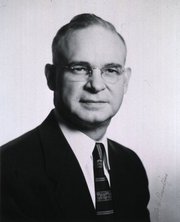This article is part of the series "A Moment in History" where we honor those who have contributed to the growth of medical knowledge in the areas of anatomy, medicine, surgery, and medical research.

Dr. Otto C. Brantigan
Otto C. Brantigan, MD. (1904-1981) An American surgeon and anatomist, Otto Charles Brantigan was born in Chattanooga, TN in 1904. Having dropped out of high school to help his family and working as a first class machinist, he decided to continue with graduate school. He studied at the Northwestern University in Chicago, where he graduated from the Medical School in 1933. In 1948 he became Chief of Surgery, and eventually became Professor of Surgery, Professor of Thoracic Surgery, and Professor of Anatomy at the Maryland School of Medicine. He retired in 1976 having earned many accolades for his profuse surgical work and publications.
As a surgeon of the times, Dr. Brantigan had a wide area of interest. His over 110 publications and surgical work range from thoracoscopy to vascular, plastic, cardiac, and orthopedic surgery. He is most remembered for the pioneer work he did on chronic obstructive pulmonary disease (COPD), emphysema and lung volume reduction surgery (LVRS), which he presented in 1958. The procedure had (at the time) a very high mortality rate (16 -20%) and Brantigan's work was not readily accepted.
It was not until J. Cooper and his team, revisited the operation proposed by Brantigan that the operation was accepted, now with new surgical stapling and staple line buttressing technology. Dr. Brantigan's name was recognized as a pioneer in lung emphysema surgery, unfortunately 14 years after his death. In 1994 his son, Dr Charles O. Brantigan delivered a beautiful biography of Dr. Otto Brantigan in the same meeting where Cooper presented his results with LVRS.
Personal note: I am proud to own one of the copies of Dr. O.C. Brantigan;s "Clinical Anatomy", a book that I use quite frequently. It is listed in my library catalog. Dr. Miranda.
Sources:
1. "Biography of Otto C Brantigan" C.O. Brantigan 1994 Meeting of the American Association for Thoracic Surgery
2. "LVRS in chronic obstructive pulmonary disease" Davies, L; Calverley, P. Thorax 1996;51(Suppl 2):S29-S34
3. ""Bilateral pneumectomy (volume reduction) for chronic obstructive pulmonary disease" Cooper, J.,The Journal of Thoracic and Cardiovascular Surgery Volume 109, Number 1:106-119
4. "The Surgical Approach to Pulmonary Emphysema" Brantigan, OC; Kress, MB; Mueller, EA. Chest. 1961; 39(5):485-499
5. "History of Emphysema Surgery" Naef, AP. Ann Thorac Surg 1997;64:1506-1508
Original image courtesy of National Institutes of Health.Biography of Dr. Otto Brantigan courtesy of Dr. Charles O. Brantigan.



